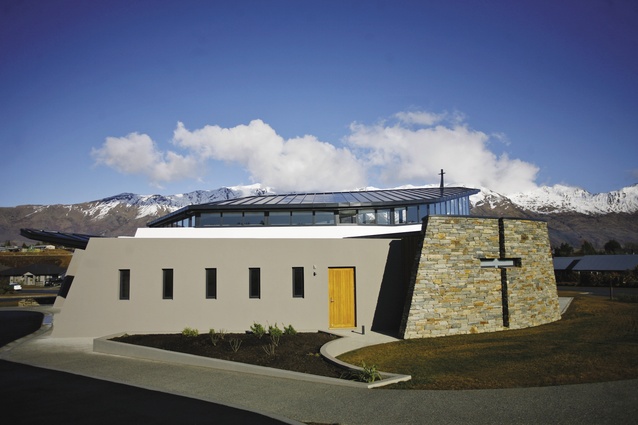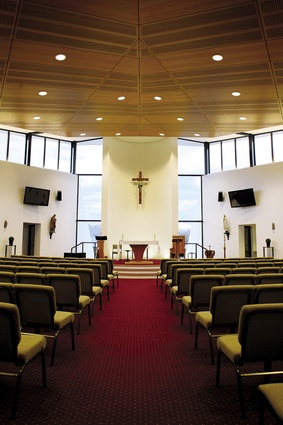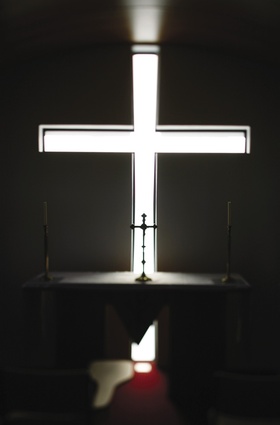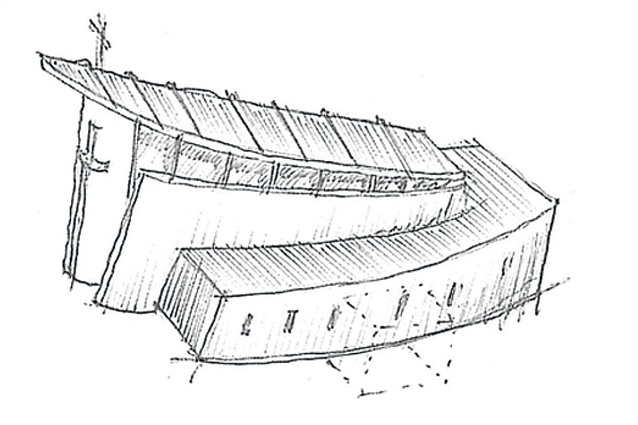Holy Family Catholic Church
With vistas across Lake Wanaka to the Southern Alps, Sarah Scott Architects’ elegant church offers a sense of occasion.
Architects don’t have many opportunities to design churches these days and the lakeside party town of Wanaka is not the first place you would think about when trying to locate one. Even so, the Upper Clutha Catholic congregation has gone against the trend of church property divestment and exploited the fact that their earlier Our Lady of Fatima church was in the middle of some of the most keenly sought real estate in the county. Its sale enabled them to fund a $2.5million project next to the Holy Family Catholic School in Aubrey Road on a site overlooking the lake and town.

Five practices were approached to submit proposals with a modest fee to cover costs. Local firm Sarah Scott Architects took the project to heart and it fell to Barry Condon, a Dublin-trained architect, recently arrived in the south, to develop initial plans and a model. Condon had seen a few churches in the course of his Catholic upbringing and was in his element with a project that had a supportive client with the long view of what a church means in a contemporary community.
The form of the church emerged from visual and liturgical themes that came readily to Condon. The curved free-standing walls can be read as cupped hands, a candle flame or a fish, all images that resonate through Catholic culture. School children from Holy Family call it the turtle, responding to the shell-like roof and triangular hood over the entrance. A cruciform plan emerged that contained two side chapels, offices, a kitchen and a small apartment for the visiting priest. It is a tight fit – made tighter by the council’s insistence on more bathrooms – and the building balances a number of functions within its spatial constraints. At 495m2 it is smaller than some of the plush holiday houses that surround it. The congregation uses it as a parish hall, which can be opened out into a larger space for meetings by sliding doors that divide the vestibule from the nave. The formal layout contrasts with the adventurous planning that followed the Vatican II reforms of the early 1960s when architects experimented with unorthodox forms. Architectural considerations seem not to concern the new churches in the larger centres where lightly-made-over commercial buildings appear to be the rule. Condon plays it with some dignity and the building is better for it.
There was a well-worn copy of a book on Le Corbusier’s Notre Dame du Haut at Ronchamp on the office shelf but Holy Family bears this overly familiar and iconic reference with grace. It is a long way from the bravura performance of Ronchamp and has elements more in common with the practices’ houses. In this relationship with the local domestic it has connections with John Scott’s Futuna Chapel as well as Church of the Good Shepherd at Tekapo. There is a sense of occasion about the building, however, and the approach to it through the suburbs and the school grounds is quite moving. Walking up to its elevated site is encouraged so that the free-standing apse with its recessed cross can be taken in. This was to have been punched through but structural constraints ruled out a gesture that may have looked right in the visualization but is not greatly missed in the finished result. Flanking curved walls of local stone are interposed with vertical cedar screens with a similar restricted palette of materials used inside, linking interior and exterior in a way that recalls the materiality of traditional churches.
This effect effaces the engineering within the structure and the steel portal frame that supports the floating roof. The drama of the building is in the apparent lightness of the upper section with its plain but generous glass clerestory band dropping down to ground level and splitting the apse away from the main walls. This allows views both in and out with the altar framed by vistas across the lake to distant mountain ranges. Careful attention to acoustics meant that heavy drapings are not needed to soften the sound and it does not have the ringing sometimes associated with stone vaults and circular plans. Built by the Queenstown branch of Naylor Love, the building shows exquisite finishing that rewards the careful detailing and the architects’ sensitive response to the brief. Altar furnishings, designed by Scott and Condon, were crafted by local volunteers with the same level of care expended on the building. Only the prosaic looking commercial pews weaken the harmonious relationship between these elements.
Blessed by Bishop Colin Campbell in February 2011, the Holy Family Church shows a community thinking about the future and building for the next three generations to use and enjoy. Sincerity is an unfamiliar aspect to experience in a building in the present age but this is what the architects have delivered.















